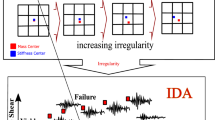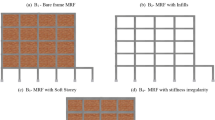Abstract
Regional earthquake loss estimation systems describe the probability of losses that could happen by a seismic hazard to a certain region. In order to develop a loss estimation system for a region, the vulnerability characteristics of the exposed structures should be integrated with earthquake hazard and the inventory of the built environment. The accurate definition of structural collapse under earthquake loads is essential for deriving reliable vulnerability functions. In this study, the collapse of concrete buildings is described in terms of both global structural response and member failure, including shear failure modes. Experimentally verified shear strength models that effectively consider the reduction of shear strength with the concrete degradation under cyclic loading are implemented in a post-processor to monitor the shear supply-demand response of concrete structures under earthquake loads. A wide range of reference structures with diverse lateral force resisting systems and building heights is selected to represent substandard buildings in the UAE. Detailed fiber-based numerical models and a diverse set of earthquake records representing different seismic scenarios in the study region are employed in dynamic response simulations at various levels of ground motion intensities up to collapse. The effectiveness of the adopted shear strength models in predicting the brittle failure modes of substandard concrete buildings is demonstrated in this study. It is concluded that shear modeling is essential for the reliable earthquake loss estimation of pre-seismic code buildings. The advanced vulnerability functions confirm the need for mitigation strategies to reduce the earthquake losses of the substandard building inventory in the study area. This comprehensive study represents a step forward for the development of a reliable loss estimation system in the UAE and the surrounding region.
Access this chapter
Tax calculation will be finalised at checkout
Purchases are for personal use only
Similar content being viewed by others
References
ACI-318 (2011) Building code requirements for structural concrete and commentary. American Concrete Institute, Detroit
ASCE/SEI-41 (2007) Seismic rehabilitation of existing buildings, standard ASCE/SEI 41-06. American Society of Civil Engineers, Reston
Bentz EC, Vecchio FJ, Collins MP (2006) Simplified modified compression field theory for calculating shear strength of reinforced concrete elements. ACI Struct J 103:614
BS8110 (1986) Structural use of concrete. British Standard Institution, London
CSI (2011) ETABS—integrated building design software. Computers and Structures Inc., Berkeley
Elnashai AS, Papanikolaou V, Lee D (2012) Zeus-NL—a system for inelastic analysis of structures—user manual. University of Illinois at Urbana-Champaign, Urbana
Howser R, Laskar A, Mo Y (2010) Seismic interaction of flexural ductility and shear capacity in reinforced concrete columns. Struct Eng Mech 35:593–616
Issa A, Mwafy AM (2014) Fragility assessment of pre-seismic code buildings and emergency facilities in the UAE. In: Second European conference on earthquake engineering and seismology (2ECEES), Istanbul, Turkey, 24–29 Aug 2014
Jeong SH, Mwafy AM, Elnashai A (2012) Probabilistic seismic performance assessment of code-compliant multi-story RC buildings. Eng Struct 34:527–537
Kim I-H, Sun C-H, Shin M (2012) Concrete contribution to initial shear strength of RC hollow bridge columns. Struct Eng Mech 41:43–65
Kowalsky MJ, Priestley MN (2000) Improved analytical model for shear strength of circular reinforced concrete columns in seismic regions. ACI Struct J 97:388–396
Krolicki J, Maffei J, Calvi G (2011) Shear strength of reinforced concrete walls subjected to cyclic loading. J Earthquake Eng 15:30–71
Mwafy AM (2012) Classification and idealization of the building stock in the UAE for earthquake loss estimation. In: 15th world conference on earthquake engineering, Lisbon, Portugal, 24–28 Sept 2012
Mwafy AM, Elnashai AS (2001) Static pushover versus dynamic collapse analysis of RC buildings. Eng Struct 23:407–424
Mwafy AM, Elnashai AM (2008) Importance of shear assessment of concrete structures detailed to different capacity design requirements. Eng Struct 30:1590–1604
Mwafy AM, Elnashai AS, Sigbjornsson R, Salama A (2006) Significance of severe distant and moderate close earthquakes on design and behavior of tall buildings. Struct Des Tall Spec Build 15:391–416
Mwafy AM, Ashri A, Issa A (2015) Probabilistic vulnerability assessment of the building inventory in an extended seismically active area in the UAE. In: 3rd international conference on engineering geophysics, Al Ain, UAE, 15–18 Nov 2015
Priestley MJN, Verma R, Xiao Y (1994) Seismic shear strength of reinforced concrete columns. J Struct Eng 120:2310–2329
Sezen H, Moehle JP (2004) Shear strength model for lightly reinforced concrete columns. J Struct Eng 130:1692–1703
Wallace JW (2010) Performance-based design of tall reinforced concrete core wall buildings. In: Earthquake engineering in Europe. Springer, London, pp 279–307
Acknowledgments
This work was supported by the United Arab Emirates University under research grants No. 31N227 and 31N132.
Author information
Authors and Affiliations
Corresponding author
Editor information
Editors and Affiliations
Rights and permissions
Copyright information
© 2017 Springer International Publishing AG
About this paper
Cite this paper
Mwafy, A., Almurad, B. (2017). Collapse Assessment of Substandard Concrete Structures for Seismic Loss Estimation of the Building Inventory in the UAE. In: Pirasteh, S., Li, J. (eds) Global Changes and Natural Disaster Management: Geo-information Technologies . Springer, Cham. https://doi.org/10.1007/978-3-319-51844-2_14
Download citation
DOI: https://doi.org/10.1007/978-3-319-51844-2_14
Published:
Publisher Name: Springer, Cham
Print ISBN: 978-3-319-51843-5
Online ISBN: 978-3-319-51844-2
eBook Packages: Earth and Environmental ScienceEarth and Environmental Science (R0)




